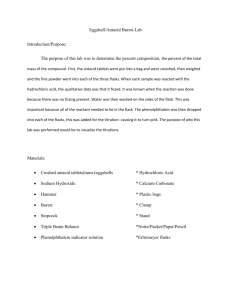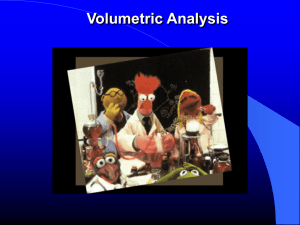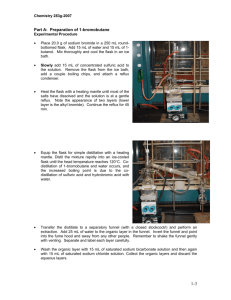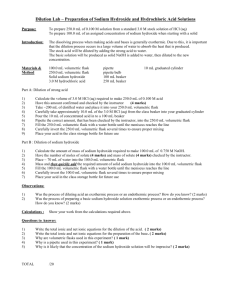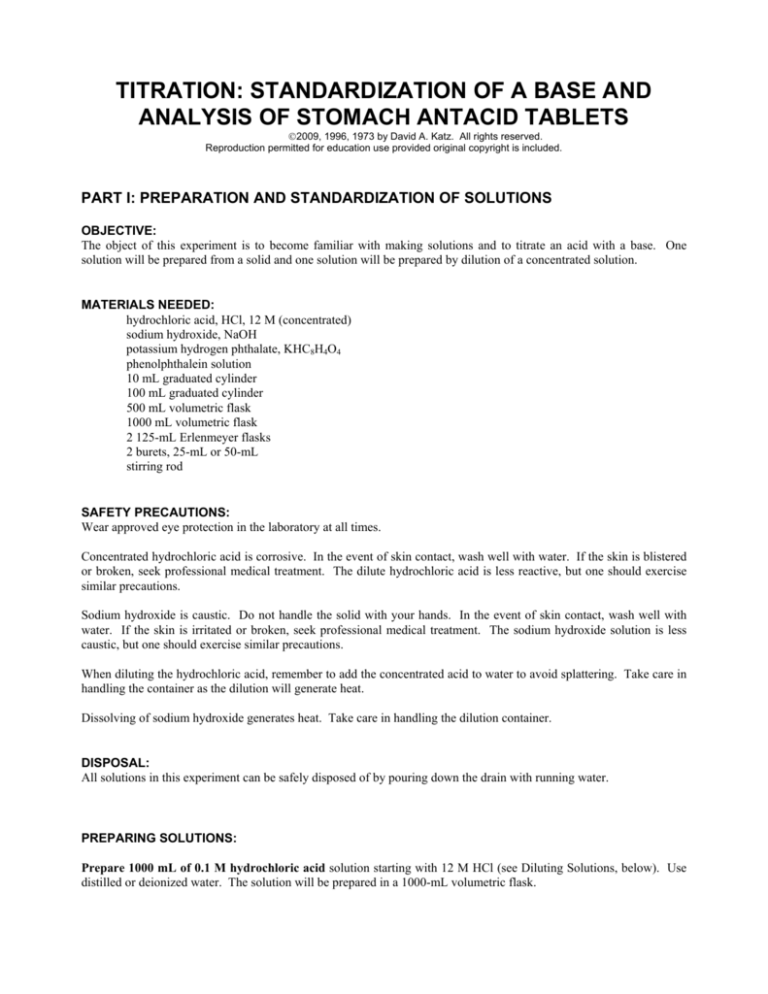
TITRATION: STANDARDIZATION OF A BASE AND
ANALYSIS OF STOMACH ANTACID TABLETS
©2009, 1996, 1973 by David A. Katz. All rights reserved.
Reproduction permitted for education use provided original copyright is included.
PART I: PREPARATION AND STANDARDIZATION OF SOLUTIONS
OBJECTIVE:
The object of this experiment is to become familiar with making solutions and to titrate an acid with a base. One
solution will be prepared from a solid and one solution will be prepared by dilution of a concentrated solution.
MATERIALS NEEDED:
hydrochloric acid, HCl, 12 M (concentrated)
sodium hydroxide, NaOH
potassium hydrogen phthalate, KHC8H4O4
phenolphthalein solution
10 mL graduated cylinder
100 mL graduated cylinder
500 mL volumetric flask
1000 mL volumetric flask
2 125-mL Erlenmeyer flasks
2 burets, 25-mL or 50-mL
stirring rod
SAFETY PRECAUTIONS:
Wear approved eye protection in the laboratory at all times.
Concentrated hydrochloric acid is corrosive. In the event of skin contact, wash well with water. If the skin is blistered
or broken, seek professional medical treatment. The dilute hydrochloric acid is less reactive, but one should exercise
similar precautions.
Sodium hydroxide is caustic. Do not handle the solid with your hands. In the event of skin contact, wash well with
water. If the skin is irritated or broken, seek professional medical treatment. The sodium hydroxide solution is less
caustic, but one should exercise similar precautions.
When diluting the hydrochloric acid, remember to add the concentrated acid to water to avoid splattering. Take care in
handling the container as the dilution will generate heat.
Dissolving of sodium hydroxide generates heat. Take care in handling the dilution container.
DISPOSAL:
All solutions in this experiment can be safely disposed of by pouring down the drain with running water.
PREPARING SOLUTIONS:
Prepare 1000 mL of 0.1 M hydrochloric acid solution starting with 12 M HCl (see Diluting Solutions, below). Use
distilled or deionized water. The solution will be prepared in a 1000-mL volumetric flask.
To prepare the hydrochloric acid solution:
Determine the amount of 12 M hydrochloric acid needed.
Fill the volumetric flask approximately 75% full with water. Use a funnel.
Add the hydrochloric acid to the volumetric flask.
Carefully, rinse any residual hydrochloric acid from the graduated cylinder and the funnel into the volumetric
flask using three 5 mL portions of distilled water from a wash bottle.
Stopper the volumetric flask and gently shake the solution.
Fill the volumetric flask to the 1000-mL mark. Stopper the flask and gently shake the solution.
If necessary, adjust the volume of the solution to 1000 mL using distilled water, and shake again.
Label the volumetric flask.
To dilute a concentrated solution to a lower concentration, the formulas to use are:
Vi =
Mf·Vf
—––––
Mi
and
V w = Vf - V i
where Mi = molarity of the initial or concentrated solution
Vi = volume of initial or concentrated solution needed
Mf = molarity of diluted or final solution
Vf = volume of diluted or final solution
Vw = volume of water needed (If a volumetric flask is used, the volume of water does
not have to be calculated.)
NOTE: Volume may be in units of mL or L, but the same units must be used for Vi and Vf.
Prepare 500 mL (0.5 L) of 0.1 M sodium hydroxide solution starting with solid sodium hydroxide (See Solutions
from Solid Solutes, below). Use distilled or deionized water. The solution will be prepared in a 500-mL volumetric
flask.
To prepare the sodium hydroxide solution:
Determine the mass of sodium hydroxide needed.
Fill the volumetric flask approximately 75% full with water. Use a funnel.
Add the sodium hydroxide to the volumetric flask.
Stopper the volumetric flask and gently shake the solution.
After the sodium hydroxide has dissolved, fill the volumetric flask to the 500-mL mark. Stopper the flask and
gently shake the solution.
If necessary, adjust the volume of the solution to 500 mL using distilled water, and shake again.
Label the volumetric flask.
To prepare a Molar solution from a solid solute, the formula to use is:
M·V·W
g = —–—–––
1000
where g = mass of solute needed, in g
M = molarity of the desired solution
V = volume, in mL, of solution to be prepared
W = Molecular mass of the solute
NOTE: The 1000 is a conversion factor from mL to L
PROCEDURE:
A. Preparation of Burets
Rinse a buret with 5 mL of 0.1 M hydrochloric acid solution. Discard the rinse solution. Repeat the rinsing two
more times. Fill the buret with 0.1 M HCl solution. Adjust the volume to the zero mark.
Rinse a buret with 5 mL of 0.1 M sodium hydroxide solution. Discard the rinse solution. Repeat the rinsing two
more times. Fill the buret with 0.1 M NaOH solution. Adjust the volume to the zero mark.
If necessary, clean the 125-mL Erlenmeyer flasks. Rinse well with water. Give the flask a final rinse with distilled
or deionized water. The flasks may be left wet for the titration.
B. Standardization of NaOH Solution
Measure 0.0020 mole (weigh to the nearest mg) of potassium hydrogen phthalate into a clean 125-mL Erlenmeyer
flask. Add 20 mL of distilled or deionized water and swirl gently to dissolve the solid. Add 3 drops of
phenolphthalein indicator solution. Titrate the solution with the sodium hydroxide until the solution in the flask
just turns pink and the color persists for at least 30 seconds. Record the volume of 0.1 M NaOH solution used.
Rinse the 125-mL Erlenmeyer flask well with water. Give the flask a final rinse with distilled or deionized water.
The flask may be left wet for another titration.
Repeat the titration procedure 2 more times.
DataAnalysis
Calculate the concentration of the sodium hydroxide solution. If the values of the three titrations do not agree, try
another titration. Use the average value of the three titrations for the concentration of the NaOH solution.
C. Standardization of HCl Solution
Measure 20 mL of the HCl solution from the buret into a clean 125-mL Erlenmeyer flask. Add 3 drops of
phenolphthalein indicator solution. Record the volume of HCl used.
Titrate the HCl solution with 0.1 M NaOH until the solution just turns pink and the pink color persists for 30
seconds without fading. Record the volume of 0.1 M NaOH used.
Rinse the 125-mL Erlenmeyer flask well with water. Give the flask a final rinse with distilled or deionized water.
The flask may be left wet for another titration.
Repeat the titration procedure 2 more times.
Data Analysis
Using the calculated concentration of the NaOH solution, calculate the concentration of the HCl solution. If the
values of the three titrations do not agree, try another titration. Use the average value of the three titrations for the
concentration of the HCl solution.
Save the solutions and the burets for Part II of the experiment.
PART II: ANALYSIS OF STOMACH ANTACID TABLETS
OBJECTIVE:
The object of this laboratory activity is to become familiar with making solutions and to titrate an acid with a base. One
solution will be prepared from a solid and one solution will be prepared by dilution of a concentrated solution.
MATERIALS NEEDED:
stomach antacid tablets
sodium bicarbonate (baking soda)
hydrochloric acid, HCl (previously prepared and standardized)
sodium hydroxide, NaOH (previously prepared and standardized)
bromphenol blue solution
100 mL graduated cylinder
2 250-mL Erlenmeyer flasks
mortar and pestle
2 burets, 50 mL
SAFETY PRECAUTIONS:
Wear approved eye protection in the laboratory at all times.
Hydrochloric acid is corrosive. In the event of skin contact, wash well with water. If the skin is blistered or broken,
seek professional medical treatment.
Sodium hydroxide is caustic. In the event of skin contact, wash well with water. If the skin is irritated or broken, seek
professional medical treatment.
Stomach antacid tablets used in this experiment has been stored under laboratory conditions and may be contaminated.
Do not taste any materials used in this experiment.
DISPOSAL:
All solutions in this experiment can be safely disposed of by pouring down the drain with running water. Solid waste
can be disposed of in the trash.
INTRODUCTION:
A television commercial claims that “Rolaids consumes 47 times its own weight in excess stomach acid” while another
commercial claims that “for fast relief of acid indigestion and heartburn due to stomach acidity... take Tums for the
tummy”.
Claims such as these raise questions such as: What is stomach acid? What is excess stomach acid? What does the
word “consume” mean with respect to the action of an antacid tablet?
Warner-Lambert Pharmaceutical Company, producer of Rolaids, says that stomach acid is approximately 0.1 M
hydrochloric acid. Excess stomach acid is a term used to describe the situation where the pH of the stomach contents
falls below 3.0 and the symptoms which are commonly called heartburn and indigestion occur. Consumes, says
Warner-Lambert, means that in a test tube a Rolaids tablet maintains the pH above 3.0 as acid is added. Test have been
made with both human gastric juice and 0.1 M hydrochloric acid where acid is added to a crushed Rolaids tablet at
constant temperature with controlled agitation until the pH is reduced to 3.0. These test are said to justify the
manufacturer’s claims.
An opposing view to the use of antacid tablets is presented by the Consumers Union, publishers of Consumer Reports.
They do not give much credit to the claims made for the various antacids and they claim that the old home remedy,
sodium bicarbonate, is safe and effective as an antacid if not used is excess.2
This experiment will attempt to evaluate the effectiveness of various antacids with respect to sodium bicarbonate and
endeavor to support or disprove the advertising claims made by the various antacid manufacturers.
PROCEDURE:
Obtain an antacid tablet. Determine the mass of the tablet and record the mass and identity of the tablet.
Crush the antacid tablet using a mortar and pestle. To minimize waste, we will sample the tablet rather than use the
whole tablet. Weigh 05 g of the crushed tablet to the nearest 0.001 g (or the precision of your balance) and transfer it to
a 250-mL Erlenmeyer flask. Add exactly 20 mL of your standardized HCl solution to the flask from a buret and gently
swirl the flask to dissolve the crushed tablet as completely as possible. Add 2-3 drops of bromphenol blue indicator
solution to the flask. At this point the solution should be yellow, if it is blue, add additional HCl in 10 mL increments
until the solution is yellow.
Titrate the solution with your standardized NaOH until the indicator just turns blue (this color change is not distinct).
Record the volume of NaOH solution required to neutralize the excess acid.
Repeat this procedure two more times using the same brand of antacid tablet.
Repeat the above procedure three more times using a different brand of antacid tablet or using 0.50 gram portions of
sodium bicarbonate (baking soda) in place of the antacid tablet. (Note: If sodium bicarbonate is used, add the acid to
the sodium bicarbonate very slowly to prevent excess frothing.)
At the conclusion of the experiment, empty the burets and rinse them three times with distilled or deionized water.
Data Analysis
Stomach antacid tablets are buffered and cannot be titrated directly with acid solutions. Excess HCl is added to
“destroy” the buffer and react with the antacid. Only the unreacted HCl is titrated with the NaOH. The moles of acid
neutralized by the antacid is determined by subtracting the moles of NaOH used from the total volume of HCl used.
This is given by the formula:
molesHCl = (VHCl x MHCl) - (VNaOH x MNaOH)
where: MNaOH = concentration of your standardized NaOH
VNaOH = volume of NaOH used in L
MHCl = concentration of HCl
VHCl = volume of HCl used in L
Calculate the moles of HCl consumed by 1.0 gram of antacid tablet (or by the sodium carbonate) using the formula:
molesHCl/g antacid =
molesHCl
––––––————––
mass antacid used
Calculate the average number of moles of acid that would be neutralized by a recommended dose of the antacid
(usually 2 tablets, but check the label of the antacid)
Show sample calculation in your laboratory report.
REFERENCES:
1. James M. Miller and Don V. Zahniser, “Antacid Analysis”, Chemistry, 44, (no. 7) July-August 1971, page 28.
2. The Editors of Consumer Reports, The Medicine Show, Revised Edition, Consumers Union, Mount Vernon, N.Y.,
1963, pages 38-40.
QUESTIONS:
1. Why is it okay to leave the flasks wet with rinse water for the titrations?
2. What is the chemical composition of the antacid tablet(s) that you used? (If the exact composition is not given on
the label, list the active ingredients.)
3. If the antacid tablet did not dissolve completely in the 0.1 M HCl solution, how can you explain this?
4. If there were variations in the weight of acid consumed for the same brand of antacid tablet, how can you explain
this?
5. Which one of the antacid that you tested appeared to be the most effective? Can you explain the difference between
them?
6. Do you think that the antacids that you tested live up to the claims of their manufacturers?





